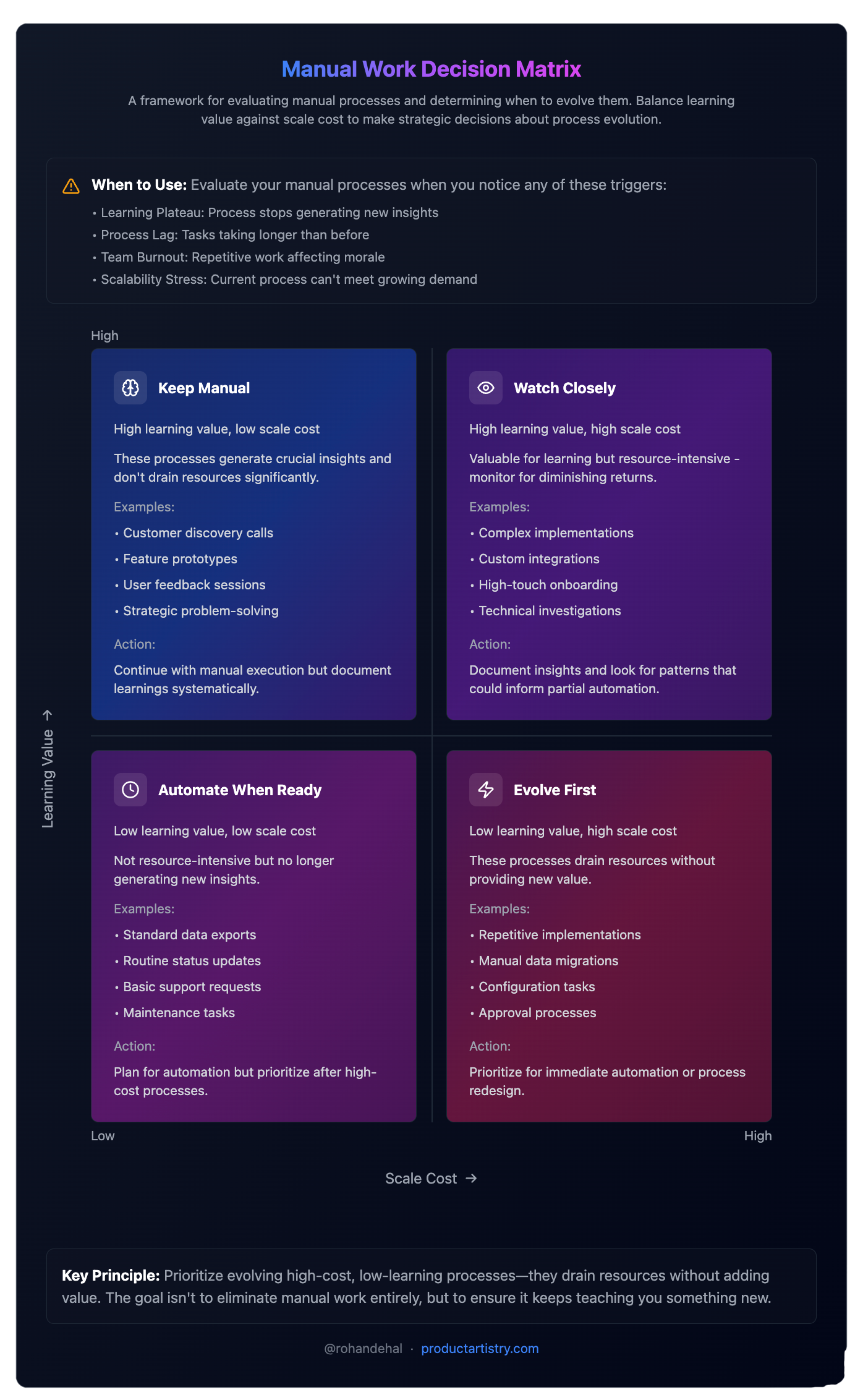When the Work That Built You Starts Breaking You
Why Manual Workflows Help You Learn Early—And How to Evolve Them to Scale
Early in my product delivery role, I thrived on the direct impact of manual, high-touch work.
Solving problems in real time felt thrilling. Each fix, customer call, and custom implementation delivered tangible results, fueling momentum and growth.
But over time, I noticed something: the work that had once felt like a superpower was slowly becoming a burden.
Here’s the lesson I learned rather quickly:
Manual work is invaluable for learning early, but every process has an expiration date.
What starts as a driver of success eventually becomes a bottleneck. That’s when evolution becomes essential—not just for workflows, but for your team and its goals:
Prevent burnout by reducing repetitive tasks.
Stay focused on high-value work instead of distractions.
Build scalability into systems that grow with you.
Knowing when to evolve is hard. Starting before things break is even harder. But it’s the only way to avoid getting trapped by the very processes that built you.
Scaling Is Like a Jenga Tower
Scaling a team or product is like building a Jenga tower:
Every new layer depends on the stability of what’s underneath.
Unstable blocks—those old, manual workflows you never replaced—don’t just stay unnoticed. Over time, they make the tower harder to balance.
At first, the wobble seems small:
A manual process here.
A workaround there.
But as you scale, every new layer adds more pressure. What started as a minor instability grows into a risk that affects the entire structure.
The risk? You keep adding layers, hoping the tower holds—until one day, it doesn’t.
Your choice:
Carefully remove and replace the unstable blocks, strengthening your foundation.
Keep stacking—and risk a collapse that disrupts everything you’ve built.
Yes, reworking your workflows takes time and effort.
But the alternative? Watching all your progress topple because the base wasn’t built to scale.
When Manual Work Stops Teaching You
The instability in your foundation doesn’t come from one big mistake—it’s the slow accumulation of old workflows that no longer serve you.
Manual work, once your biggest strength, stops delivering value when it stops teaching you something new.
At first, manual workflows are invaluable. They help you:
Learn directly from customers.
Identify edge cases and opportunities.
Uncover patterns that shape your strategy.
But here’s the problem: that learning doesn’t last forever.
Over time, the signals become noise:
Customer interactions feel routine, not revealing.
Quick fixes turn into slow, frustrating workarounds.
Repetition drains energy instead of fueling momentum
Worse, manual processes can create information silos that fragment your team.
Teams working in isolation rely on outdated information or inconsistent methods.
Misalignment and duplication of effort become common.
Valuable insights get trapped in inboxes, spreadsheets, or individual minds—out of reach for the broader team.
When manual work stops being insightful, it starts being costly.
Hidden inefficiencies accumulate, creating process debt that:
Drains your team’s focus.
Stalls innovation.
Saps morale.
These aren’t signs of failure—they’re signs of success pressing against its limits. Recognizing these limits is the first step toward building something better.
Solution Framework: Evolving Your Workflows
The hardest part about evolving workflows isn’t just recognizing the faults in your foundation—it’s acting before they become unfixable. Most teams fall into one of two traps:
They wait too long. By the time they act, inefficiencies have compounded, making fixes feel overwhelming and disruptive.
They overcorrect. In their rush to automate or streamline, they lose the flexibility and insights that manual work once provided.
The key is to approach evolution systematically, not reactively.
Here’s how:
1. Evaluate Manual Work with a Clear Framework
Not all manual work needs to change—some of it is essential to what makes your team and product thrive. The goal isn’t to eliminate manual processes entirely—it’s to optimize them, keeping what works and evolving what doesn’t.
Here’s a decision matrix to help you evaluate workflows and prioritize what needs to evolve:
High Learning, Low Cost (Top Left Quadrant) → Keep Manual:
Early-stage customer calls, user interviews, or prototyping that generate actionable insights.High Learning, High Cost (Top Right Quadrant) → Watch Closely:
Custom integrations or complex workflows that teach you something critical but are resource-intensive.Low Learning, Low Cost (Bottom Left Quadrant) → Automate When Ready:
Routine status updates, standard exports, or other predictable tasks that no longer require human input.Low Learning, High Cost (Bottom Right Quadrant) → Evolve First:
Repetitive tasks like manual data migrations or approvals that drain resources without adding value.
Prioritize evolving high-cost, low-learning processes—they drain resources without adding value.
2. Evolution Triggers: Know When to Act
Waiting until a process breaks isn’t a strategy—it’s a liability. The impact often extends beyond workflows, affecting your team’s morale and productivity. That’s why it’s crucial to recognize these triggers early and flag them for action:
Learning Plateau: Workflows stop generating new insights or patterns.
Process Lag: Once-quick tasks take disproportionately longer.
Team Burnout: Repetitive, low-value work drains energy and motivation.
Scalability Stress: Growing customer demand pushes processes—and people—beyond their limits.
Define these triggers clearly and ensure they’re understood across your team. Proactively monitoring for them allows you to address inefficiencies before they cascade into larger issues.
Process evolution isn’t just about fixing broken workflows—it’s about building awareness and adaptability into your team’s approach.
3. Evolve Gradually, Not Dramatically
Recognizing triggers is only the first step. The real challenge lies in evolving workflows without disrupting your team or losing momentum. The best time to make changes is when processes are still functioning—but just barely. This gives you room to act deliberately rather than reactively.
Here’s how to evolve workflows effectively:
Start Small: Identify a single high-cost, low-learning process to refine or automate.
Test Incrementally: Pilot new tools or workflows with a small team before scaling changes across the organization.
Focus on Modularity: Build improvements that integrate with existing systems and can scale gradually.
This method ensures that workflow evolution is manageable, minimizes disruptions, and keeps your team aligned as you adapt.
Evolving Without Losing What Made You Great
It’s tempting to think of process evolution as a sacrifice—letting go of the manual work that got you here. But evolution isn’t about erasing those early workflows; it’s about honoring them by building something better.
What made manual work valuable wasn’t the effort—it was the insights.
Evolving doesn’t mean losing flexibility—it means channeling it more effectively.
By building systems that teach you, scale with you, and adapt over time, you can keep learning without falling into the traps of process debt.
The Bottom Line: Know When to Let Go
Manual workflows are an essential part of growth—they teach you, shape your perspective, and drive early results. But they’re not meant to last forever.
The best teams don’t evolve because they’re forced to—they evolve because they want to focus on what matters most:
Learning: Staying curious and open to new insights.
Iterating: Continuously improving based on those insights.
Building: Creating systems and solutions that can sustain long-term growth.
The work that once built you doesn’t have to break you. When you let it evolve, it becomes the foundation for something even stronger.
By embracing change, you free yourself to focus on what really drives progress: solving new problems, uncovering fresh opportunities, and building systems that grow with you.
Three ways to help support my work:
Like, Comment, and Share—Help increase the reach of these ideas.
Subscribe for free—Get future posts and join our community.
Become a paid subscriber—Support my independent journey.
Keep Iterating,
—Rohan
→ Connect with me: LinkedIn, Bluesky, Threads, X, or Email—I’m always open to interesting conversations and opportunities!







This was a super helpful post, Rohan. I love the simple usage of quadrants to assess the situation.